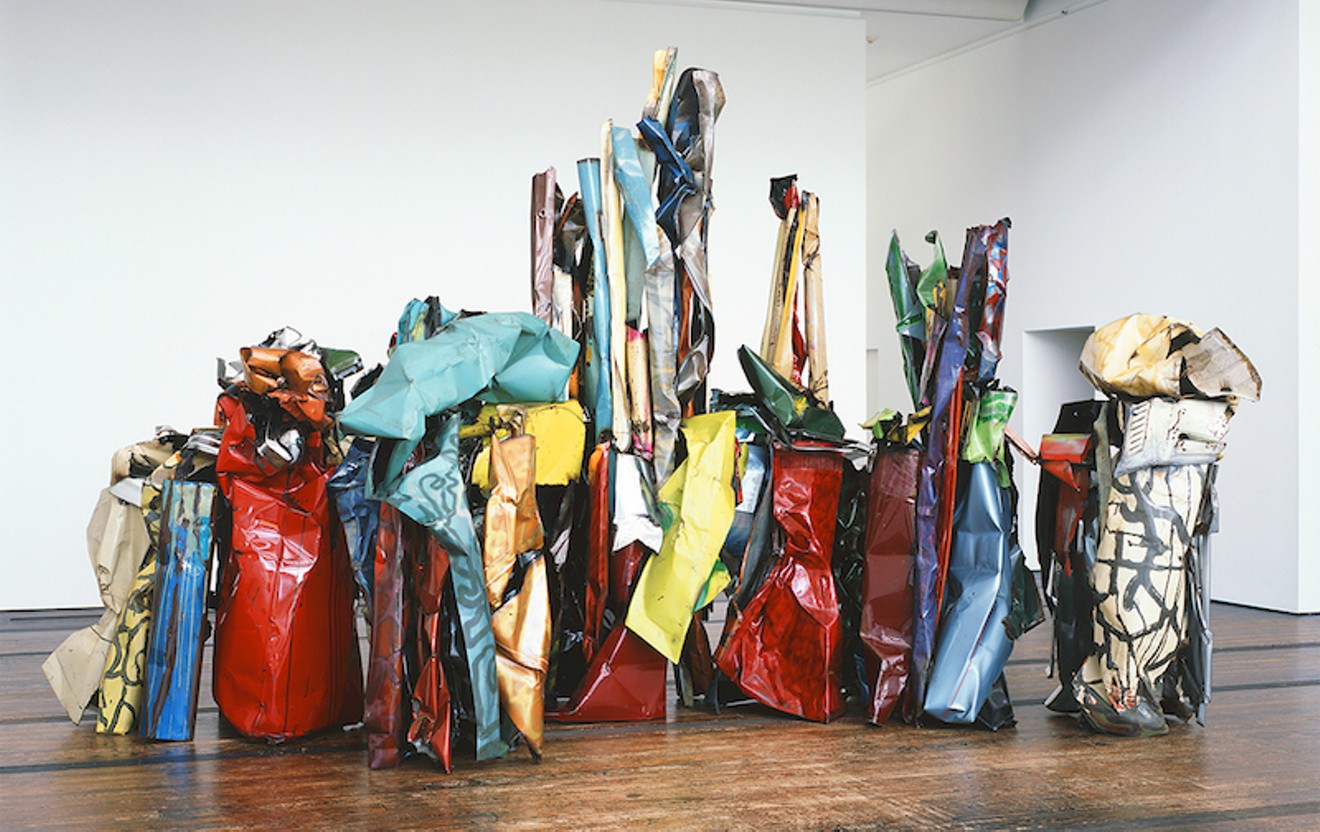Note: The Menil Collection is currently closed because of Hurricane Harvey. See menil.org or its Facebook page for updates.
It’s hard to pass up a treasure hunt, even when the treasure is in full view. And a treasure hunt is what The Menil Collection is offering us, all the way through the end of the year and beyond, with “Thirty Works for Thirty Years.” There’s even a map to show the way.
The exhibition, which isn’t in one gallery but rather is spread over the entire Menil campus, has been curated by Clare Elliott, Menil Associate Curator, and Toby Kamps, formerly at the Menil but soon to move across town to be Director of the Blaffer Art Museum at the University of Houston, with input from a dozen other members of the Menil staff.
Let me be clear up front: This is a special event, rather than a special exhibition. But then neither life nor art always have to be special exhibitions to be exciting. This time the Menil team didn’t borrow art from around the world and truck it to Houston. For this treasure hunt they dipped into the vaults right there in the gray building on Sul Ross, pulled out 30 extra special pieces from among the 10,000 in the permanent collection – one for each year since the museum opened in 1987 – and sprinkled them throughout the permanent collection galleries.
You might think that after 30 years of plowing that same permanent collection field there would be nothing new to find, and it is true that some of the works that make up “Thirty for Thirty” have been on view many times through the decades, some almost constantly. Some have not been shown before, but even the old familiars seem renewed by the treasure hunt.
To begin, pick up the “Thirty Works for Thirty Years” booklet at the reception desk, open to the centerfold map and start searching the galleries for blue dots with dates. As you’ll see from the map, they extend to all corners of the Menil campus – one is even outdoors. In the spirit of the hunt, I decided that I’d hit all the dots and I’m glad I did. Even though I’ve been visiting the Menil for the whole 30 years it has been open, there are areas I hardly ever get to; just not of much interest to me, I decided somewhere along the way.
One such section contains the Byzantine art gallery. Been there, seen that, way back when. What a thrill looking ontce again after eons at Entry into Jerusalem, painted in tempera and gold leaf on wood, possibly in Constantinople, probably in the mid-15th century. Oh yeah, contemporary is really hot now, but hardly any of it comes close to this old piece, with tiny people hanging like Christmas ornaments from misshapen trees above Jesus on his donkey on the road to the city; a city flattened into a perspectiveless plane along with Jesus and the mountains and the aristocratic citizens in their scarlet and black-striped tunics. How modern is that?
One of the things we’ve come to expect from Menil installations is some drama with our art. Nothing too heavy-handed or kitchy; just enough to give some snap to viewing and maybe make for a smile. I’ve seen John Chamberlain crushed metal sculptures (literally old cars sculpted with a junkyard crusher in some cases) many times at Menil – they have lots of them. But I don’t remember ever before seeing his American Tableau from 1984. Maybe I have, but this time in a gallery all its own, looming like the jagged peaks of the Andes (though peaks in fauve-worthy multi-colors), it made me gasp.
A little further on, in a different part of the museum, I found another piece in a gallery all alone: Richard Tuttle’s No.7 from 1992, seemingly suspended by a graphite line from the ceiling, tiny and so near the floor that at first the gallery seemed empty. When the big/little contrast sunk in, I laughed. It’s not an accident, I think (or if accidental, how lucky Menil curators are), but a subtle way of making sure I’ve been paying attention. The de Menils were happy to share their art with us, but they always expected us to do our part and look with our minds as well as our eyes. Just passing in front of their art was never enough.
It’s big little linkages like that pairing – and the Kara Walker pop-up silhouettes floating above the pages of her book, Freedom, a Fable from 1997 at one end of the building, while mini-men in overcoats and bowler hats levitate in René Magritte’s Golconda of 1953 at the other – that can make art/viewer interactions at the Menil so exhilarating. Big little strokes that don’t require major ceiling renovations and the installation of light and sound systems, as have sometimes been necessary elsewhere in town.
The Menil, unlike some museums, seems intent on keeping the art museum-going experience easy and pleasant, as well as exciting: There’s no admission fee and there never has been; parking is free and accessible; selfies are not only not encouraged, they’re not allowed. Rather than spectacle, the Menil presents us with intelligent, thoughtful exhibitions that challenge us to look closely and make connections. The point is not to wow us, but to help us say “Wow” as we realize the pleasure and power of art.
In some ways we’ve come to take The Menil Collection for granted. It’s always been there for most of us and so we expect that it always will be. That expectation will be tested next year when the main building closes for several months of renovation. By then the Menil Drawing Institute will be open, so we’ll still have a Menil to go to, but I suspect we’ll realize how much we’re missing.
And one more point: I want to commend the curators particularly for bringing out of storage a work by Houston artist Jim Love, an iron and steel sculpture from 1965 titled Flowers. There’s only this one piece by a Houston artist that I spotted, but that’s better than the usual none, and equals in number to the three-in-one work by mid-century Houston ceramicist Ruth Lairs, currently on view at the Museum of Fine Arts, Houston. Two major collecting art museums in our city, with thousands of works of art on view in their galleries, and only two by Houston artists. I’m just saying.
The Menil is a treasure. We all know it, even if we sometimes take it for granted. Take advantage of this 30th anniversary treasure hunt to discover it or discover it anew.
“Thirty Works for Thirty Years”
Through January 28, 2018. The Menil Collection, 1533 Sul Ross, 713-525-9400, menil.org.
Support Us
Houston's independent source of
local news and culture
account
- Welcome,
Insider - Login
- My Account
- My Newsletters
- Contribute
- Contact Us
- Sign out
The Menil's "Thirty Works for Thirty Years" Is a True Treasure Hunt
Randy Tibbits August 30, 2017 5:00AM

John Chamberlain, American Tableau (1984)
Courtesy of The Menil Collection, Houston / © 2017 Fairweather & Fairweather LTD / Artists Rights Society (ARS), New York
[
{
"name": "Related Stories / Support Us Combo",
"component": "11591218",
"insertPoint": "4",
"requiredCountToDisplay": "4"
},{
"name": "Air - Billboard - Inline Content",
"component": "11591214",
"insertPoint": "2/3",
"requiredCountToDisplay": "7"
},{
"name": "R1 - Beta - Mobile Only",
"component": "12287027",
"insertPoint": "8",
"requiredCountToDisplay": "8"
},{
"name": "Air - MediumRectangle - Inline Content - Mobile Display Size 2",
"component": "11591215",
"insertPoint": "12",
"requiredCountToDisplay": "12"
},{
"name": "Air - MediumRectangle - Inline Content - Mobile Display Size 2",
"component": "11591215",
"insertPoint": "4th",
"startingPoint": "16",
"requiredCountToDisplay": "12"
}
,{
"name": "RevContent - In Article",
"component": "12527128",
"insertPoint": "3/5",
"requiredCountToDisplay": "5"
}
]
KEEP THE HOUSTON PRESS FREE...
Since we started the Houston Press, it has been defined as the free, independent voice of Houston, and we'd like to keep it that way. With local media under siege, it's more important than ever for us to rally support behind funding our local journalism. You can help by participating in our "I Support" program, allowing us to keep offering readers access to our incisive coverage of local news, food and culture with no paywalls.
Randy Tibbits is an independent art writer and curator, specializing in the art history of Houston. He is a member of the Board of Directors of CASETA: Center for the Advancement and Study of Early Texas Art and the coordinator of HETAG: Houston Earlier Texas Art Group. He writes art exhibition reviews for Houston Press from time to time.
Trending Arts & Culture
- The 10 Best And Most Controversial Hustler Magazine Covers Ever (NSFW)
- Whose Story is It in The Father at 4th Wall Theatre Co.
- Top 5 Sickest Stephen King Sex Scenes (NSFW)
-
Sponsored Content From: [%sponsoredBy%]
[%title%]

Don't Miss Out
SIGN UP for the latest
arts & culture
news, free stuff and more!
Become a member to support the independent voice of Houston
and help keep the future of the Houston Press FREE
Use of this website constitutes acceptance of our
terms of use,
our cookies policy, and our
privacy policy
The Houston Press may earn a portion of sales from products & services purchased through links on our site from our
affiliate partners.
©2024
Houston Press, LP. All rights reserved.





